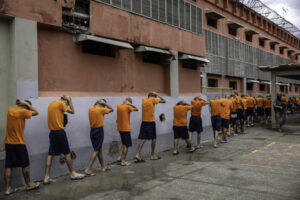To: Colleagues
From: Geoff Thale and Clara Rodriguez, WOLA
Margaret Popkin, Due Process of Law Foundation
Re: Youth Gangs in Central America
Date: February 22, 2005
In recent months, youth gangs in Central America have been the subject of media attention, in both the United States and in the Central American countries. This attention has led to debate both about the nature of the problem, and about how best to respond to it. Below we outline our views about some of the major issues.
1. Central American youth gang violence is a serious problem. Youth gangs present serious threats to public order in Guatemala, El Salvador, and Honduras, as well as in southern Mexico and parts of the United States, and public opinion demands that government officials take steps to respond.
2. In this context, the problems caused by youth gang violence in Central America should not be exaggerated or distorted. Youth gang violence is a serious threat to citizen security and governments must respond. But the problem does not require “state of emergency”-type responses. Central American governments should respond in a strong, yet measured and thoughtful way, rather than being driven by a crisis mentality.
Crime is a major problem in the region. Organized criminal groups engage in drug trafficking, smuggling, car theft, kidnapping, and other activities. Highway robbery and muggings by individuals and small groups are common. Firearms are readily available. Youth gang violence is only one part of this larger phenomenon.
Discussions of youth gangs in Central America sometimes suggest that gangs are developing links to Islamic terrorists, or that youth gangs have morphed into major drug-trafficking networks, or that youth gangs threaten the political stability or control of governments in the region. These claims overstate the problem, and are based on anecdotes, or speculation. Often rumor appears to become fact.
Reliable information about the number of gang members in the various Central American countries is lacking (and there is not even real agreement about what defines a young person as a gang member.) Officials responsible for public security do not have adequate information about the number and types of crimes that gang members commit, nor do they necessarily have a complete picture of gang structures, organization, or leadership. The available facts suggest that the problem of youth gang violence is real and serious, that gang members can be iolent and dangerous, and that governments must respond before the problem
gets worse. But governments’ responses should be appropriate and proportionate to the actual problem, not to distortions based on the latest newspaper headline.
3. Responses to the problems of youth gang violence in Central America need to be comprehensive, addressing prevention and rehabilitation issues as well as police and law enforcement approaches. Understandably, but unfortunately, responses to date have emphasized law enforcement approaches over prevention and rehabilitation. This imbalance needs to be redressed.
4. Some recent law enforcement initiatives have raised human rights and due process concerns.
Legislation and practice have sometimes given police broad and virtually unchecked powers to arrest young people whom officers believe to be involved in gangs.
Legislation on gang activity has tended to erode recently enacted distinctions between the treatment of juveniles and the treatment of adults.
Police, especially in Guatemala and Honduras, have been accused of involvement in the disappearance and extra-judicial execution of suspected gang members, including some youths actively participating in rehabilitation programs. Riots and fires have broken out in overcrowded prisons and alleged gang members,
many still in pre-trial detention, have died under suspicious circumstances.
Law enforcement efforts should be vigorous and help ensure citizen security. They should not undercut the progress on police and justice reform that Central America has made in the last decade – or applicable international standards.
5. There is no magic formula that will solve the problem of youth violence in Central America. But Central American governments and civil societies, with support and technical assistance from the donor community, can take steps to address the problem.
These steps include:
• a serious focus on school and community based prevention programs;
• appropriate, targeted law enforcement efforts that respect human rights and due process of law, and that are coordinated with school and community programs;
• support, both political and financial, for rehabilitation programs and the development of alternatives for youths who want to leave gangs.


